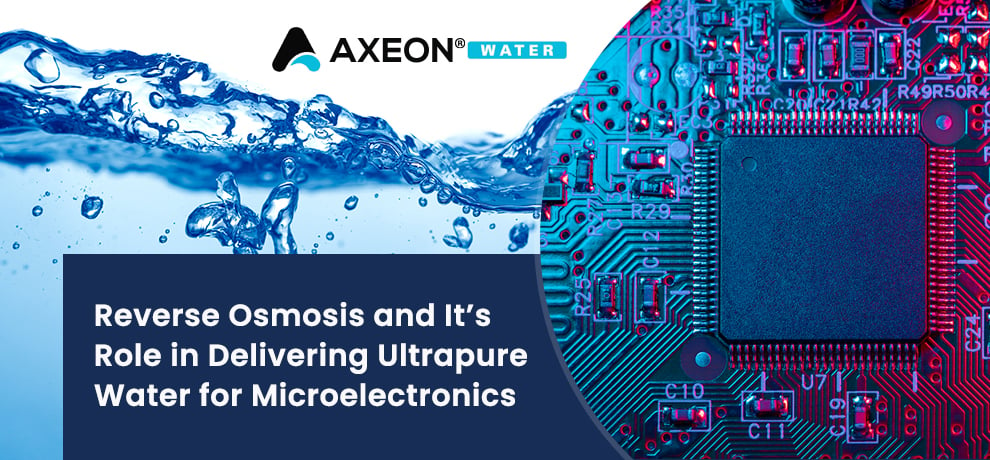Technical Articles

Reverse osmosis is a high-pressure membrane process that removes dissolved solids, ions, and particulates to produce ultrapure water essential for microelectronics manufacturing. In semiconductor fabrication, even trace contaminants-silica, total organic carbon (TOC), or metals-can cause defects on wafers and reduce yields. Reverse osmosis ensures consistent water quality and stringent purity standards by leveraging semipermeable membranes and post-treatment polishing.
Why Ultrapure Water Matters in Microelectronics
Trace contaminants like silica, total organic carbon (TOC), metals, and colloids, even at parts-per-billion levels, can etch semiconductor wafers and cause yield loss. Ultrapure water (UPW) with resistivity ≥18.2 MΩ·cm, TOC <10 ppb, and near-zero total dissolved solids (TDS) is essential for rinse, etc, and cleaning steps in semiconductor device fabrication. Reverse osmosis serves as the frontline purification, delivering consistent, high-quality water to meet the industry’s stringent purity standards.
Common Impurities and Pretreatment Strategies
Feedwater for reverse osmosis often contains high total dissolved solids (TDS), organic compounds, bacteria, and colloids that foul membranes and reduce efficiency. Pretreatment strategies remove these impurities: activated carbon filters adsorb organic matter and chlorine, media filtration captures large particulates, and ultrafiltration (UF) membranes eliminate bacteria and colloids. Effective pretreatment safeguards semipermeable membranes, prevents scaling and fouling, and ensures consistent high-purity water production for microelectronics manufacturing.
How Reverse Osmosis Systems Deliver High-Purity Water
Semipermeable membranes in RO systems reject >99% of dissolved solids, ions, and particulates by applying high pressure to overcome osmotic gradients. Flux rates are optimized to balance throughput and purity, ensuring maximum contaminant removal. Permeate then undergoes post-treatment ion exchange or TOC polishing to eliminate residual ions and organic compounds, achieving resistivity ≥18.2 MΩ·cm. Automated monitoring of pressure differentials, conductivity, and TDS ensures consistent high-purity water for critical rinse and etch processes in microelectronics fabrication.
Comparing RO with Alternative UPW Purification Technologies
Reverse osmosis (RO) vs. alternative UPW technologies: Ion exchange uses resin to swap ions but requires frequent regeneration and higher consumables; distillation achieves near-zero TDS but is energy-intensive with high capital cost; advanced oxidation processes (AOP) remove organic compounds and TOC but cannot eliminate inorganic ions alone. RO balances high rejection (>99%), moderate energy use, and lower operating costs, making it the frontline choice for semiconductor-grade water purification.
Environmental Impact, Water Reuse and Sustainability in Microelectronics
RO systems generate a concentrate stream; integrating water reuse and recycle loops reduces freshwater demand and wastewater discharge. High-recovery RO (>75%) with zero-liquid discharge options minimizes waste, while energy-recovery devices lower carbon footprint. Sustainable strategies-hybrid RO-UF pretreatment, onsite wastewater recycle, compliance monitoring-help semiconductor fabs meet stringent environmental targets, conserve raw water, and align with industry sustainability and reuse standards.
Axeon Water’s R1-Series Reverse Osmosis Systems
Axeon Water’s R1–Series systems are engineered to deliver 1,800–21,600 gpd of ultrapure water with nominal TDS rejection >98.5%. Available in single-pass configurations with 1–12 FRP membrane vessels housing ultra-low energy 4″×40″ membranes, the R1–Series features a multi-stage stainless steel booster pump, S-150 programmable RO controller, integrated flow and pressure gauges, and a pre-plumbed skid-mounted design. Components are pre-assembled, wired and factory-tested, reducing installation time and footprint. Energy-efficient operation (20% less than standard systems) and customizable options ensure reliable performance and low maintenance for semiconductor fabrication applications.
Axeon Water’s X1-Series Reverse Osmosis Systems
Axeon Water’s X1–Series combines advanced semipermeable membranes in a triple-pass configuration to achieve >99% TDS rejection and boron levels below 10 ppb. Modular stainless-steel skids support 4–16 membrane vessels, delivering 3,000–30,000 gpd of ultrapure water with resistivity ≥18.2 MΩ·cm and particulate counts <1 particle/mL. Integrated PLC controls track conductivity, TOC and pressure differentials, while CIP capabilities minimize downtime. Designed for cleanroom and UPW loop integration, energy-efficient pumps and high-recovery operation cut energy use by 25%, reducing lifecycle costs and ensuring reliable performance for semiconductor manufacturing.
R1-Series vs. X1-Series: Performance, Footprint & Cost Comparison
The R1-Series delivers 1,800–21,600 gpd at >98.5% TDS rejection in a compact, skid-mounted footprint ideal for small to mid-scale fabs, with moderate capital costs and 20% energy savings. The X1-Series produces 3,000–30,000 gpd at >99% rejection and <10 ppb boron on modular stainless-steel skids, supporting cleanroom integration. While X1’s upfront investment is higher, its 25% energy reduction, higher recovery and lower OPEX yield a faster ROI for large-scale semiconductor operations.
Economic Considerations & Return on Investment for RO Deployment
Economic considerations for RO deployment include upfront capital expenditure for equipment and installation and ongoing OPEX-energy, membrane replacement (every 3–5 years) and pretreatment consumables. High-recovery designs and energy-efficient pumps lower utility costs by up to 25%. Reducing wafer defects by 20–30% can boost fab yields, translating into a 12–24 month payback. Lifecycle savings from extended membrane life, minimal downtime and lower chemical usage result in significant ROI and cost predictability for semiconductor manufacturing facilities.
Frequently Asked Questions
Q1: Can RO alone meet UPW specs?
A: No. RO purifies; post-treatment ion exchange and TOC control finalize UPW.
Q2: How does RO integrate with ion exchange?
A: RO removes ions; ion exchange polishes residuals to achieve ultrapure resistivity.
Q3: What is the typical RO maintenance schedule?
A: Membranes replaced every 3–5 years; quarterly cleaning; weekly pretreatment monitoring.
Q4: How is RO wastewater managed?
A: Concentrate is recycled or treated for reuse, minimizing discharge.
Conclusion and Next Steps
Reverse osmosis is essential for ultrapure water in microelectronics. Axeon Water’s R1 and X1 series offer scalable, energy-efficient solutions to meet stringent purity standards. Contact us for a customized RO system design and on-site evaluation.
THE RIGHT SOLUTION FOR YOU
Contact us today for more information about our products and services.
CONTACT US
